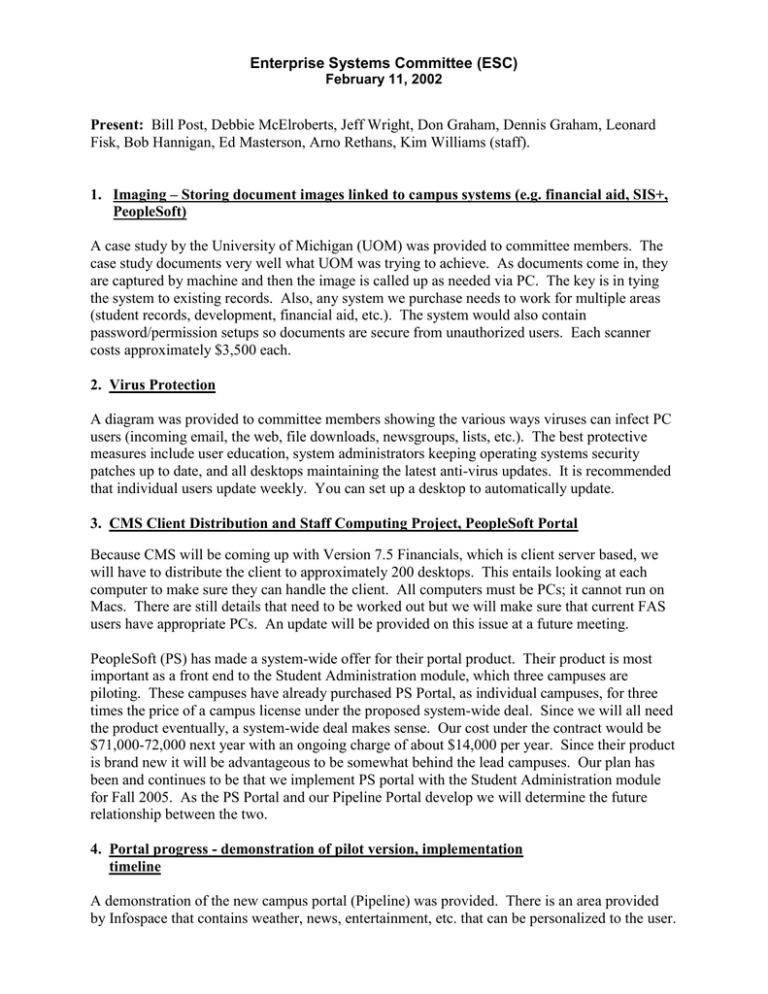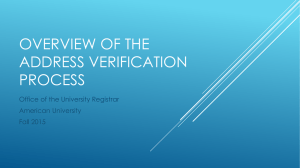Enterprise Systems Committee (ESC) Present:
advertisement

Enterprise Systems Committee (ESC) February 11, 2002 Present: Bill Post, Debbie McElroberts, Jeff Wright, Don Graham, Dennis Graham, Leonard Fisk, Bob Hannigan, Ed Masterson, Arno Rethans, Kim Williams (staff). 1. Imaging – Storing document images linked to campus systems (e.g. financial aid, SIS+, PeopleSoft) A case study by the University of Michigan (UOM) was provided to committee members. The case study documents very well what UOM was trying to achieve. As documents come in, they are captured by machine and then the image is called up as needed via PC. The key is in tying the system to existing records. Also, any system we purchase needs to work for multiple areas (student records, development, financial aid, etc.). The system would also contain password/permission setups so documents are secure from unauthorized users. Each scanner costs approximately $3,500 each. 2. Virus Protection A diagram was provided to committee members showing the various ways viruses can infect PC users (incoming email, the web, file downloads, newsgroups, lists, etc.). The best protective measures include user education, system administrators keeping operating systems security patches up to date, and all desktops maintaining the latest anti-virus updates. It is recommended that individual users update weekly. You can set up a desktop to automatically update. 3. CMS Client Distribution and Staff Computing Project, PeopleSoft Portal Because CMS will be coming up with Version 7.5 Financials, which is client server based, we will have to distribute the client to approximately 200 desktops. This entails looking at each computer to make sure they can handle the client. All computers must be PCs; it cannot run on Macs. There are still details that need to be worked out but we will make sure that current FAS users have appropriate PCs. An update will be provided on this issue at a future meeting. PeopleSoft (PS) has made a system-wide offer for their portal product. Their product is most important as a front end to the Student Administration module, which three campuses are piloting. These campuses have already purchased PS Portal, as individual campuses, for three times the price of a campus license under the proposed system-wide deal. Since we will all need the product eventually, a system-wide deal makes sense. Our cost under the contract would be $71,000-72,000 next year with an ongoing charge of about $14,000 per year. Since their product is brand new it will be advantageous to be somewhat behind the lead campuses. Our plan has been and continues to be that we implement PS portal with the Student Administration module for Fall 2005. As the PS Portal and our Pipeline Portal develop we will determine the future relationship between the two. 4. Portal progress - demonstration of pilot version, implementation timeline A demonstration of the new campus portal (Pipeline) was provided. There is an area provided by Infospace that contains weather, news, entertainment, etc. that can be personalized to the user. Students can access a list of their classes; they can go straight to WebCT, and they can go to the campus website and various other sites from the portal. An entire committee is working on putting together policies and procedures on how to get information to students' portal pages. Students will eventually be able to request their classes, update their addresses, see grades, holds, etc. Announcements can be customized by class, college, or to a specific individual. Faculty members will be able to send messages to students registered in their classes. Specific information can be input about classes they are teaching. Faculty can send emails to entire classes or select specific students. Additional features such as support for groups and clubs and syncing with your palm pilot are included in this Spring’s release. The Portal Steering Committee will address the timing of upgrades, looking towards this summer which is our earliest window of opportunity. The portal timeline was dispersed. We are currently in the middle of doing functional and technical testing. We hope to have the portal live in mid-March to April for a select group of students and faculty. We hope to support summer term WebCT and support the summer program for registration. One last diagram was dispersed showing the complexities of a single-sign-on environment. 5. Adjournment All other discussions were deferred to a future meeting. 2

